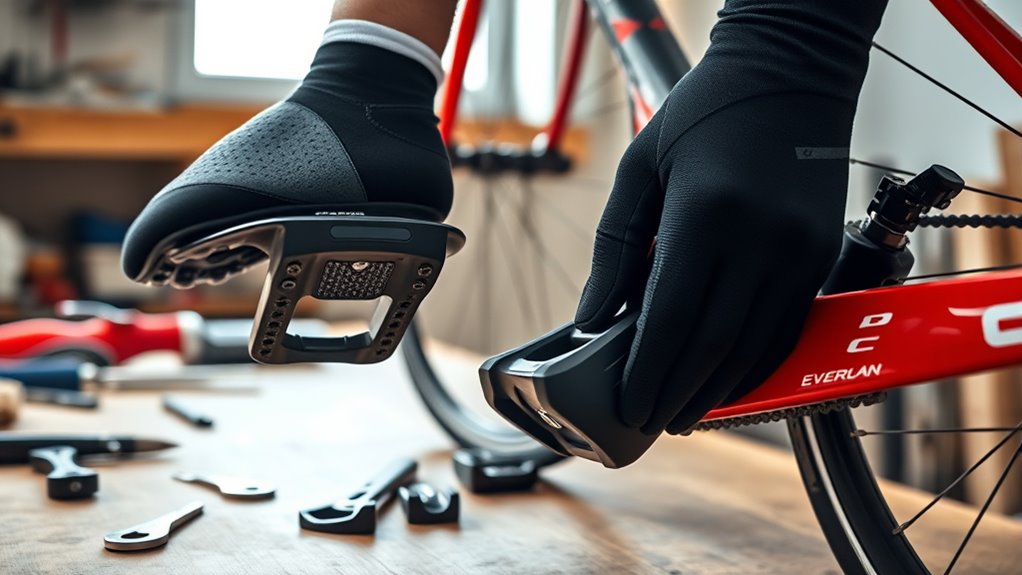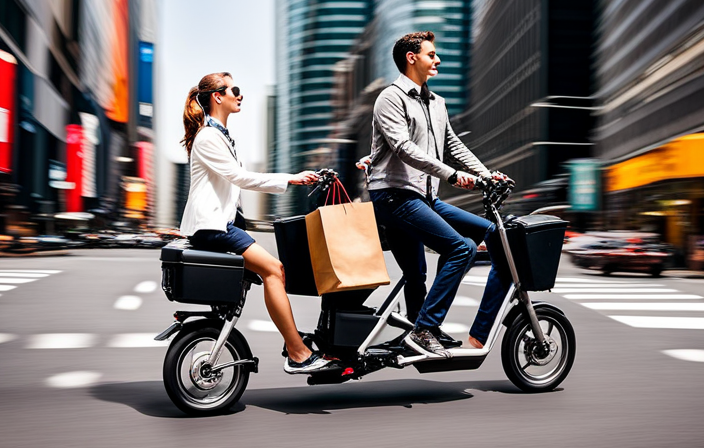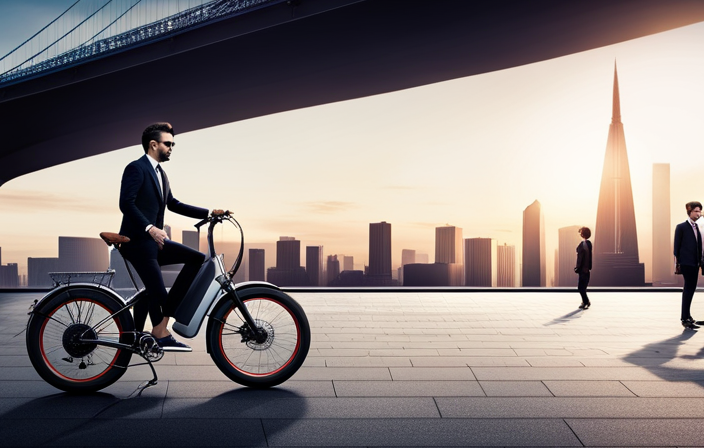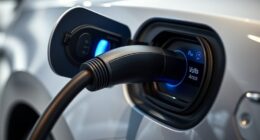To troubleshoot clipless pedals quickly, start by checking your cleat position—make sure it’s aligned properly over the pedal axle and secured tightly. Then, inspect the engagement mechanism for dirt or corrosion and lubricate lightly if needed. Confirm that your cleats fit your pedals securely and replace worn ones. Adjust pedal tension for smooth clipping and unclipping. Keeping everything clean and well-maintained helps prevent issues. If you follow these steps, you’ll be ready to ride confidently in no time.
Key Takeaways
- Check and adjust cleat position to ensure proper alignment and smooth clipping in and out.
- Inspect pedal and cleat engagement mechanism for dirt, debris, or corrosion; clean and lubricate as needed.
- Verify cleat and pedal compatibility and replace worn cleats to improve security and release.
- Adjust pedal tension to match your preferred release firmness and prevent accidental unclipping.
- Regularly inspect, clean, and lubricate pedals and cleats to maintain optimal performance and safety.
Checking and Adjusting Cleat Position

To make certain your clipless pedals function properly, start by checking and adjusting your cleat position. Proper cleat alignment ensures your foot sits correctly on the pedal, reducing discomfort and improving power transfer. Begin by loosening the cleats and examining their position relative to your shoe’s sole. Make sure they are aligned symmetrically, with the cleat’s ball of the foot directly over the pedal axle. Pay attention to shoe compatibility, as different brands and models may require specific cleat placements. Adjust the cleats so your knees track straight and your feet feel natural while pedaling. Once aligned, tighten the bolts securely. This simple step prevents issues like pedal slipping or hot spots, ensuring a smooth, efficient ride. Additionally, color accuracy in your setup can influence how comfortable and natural your pedaling experience feels, especially during long rides.
Inspecting and Lubricating the Engagement Mechanism
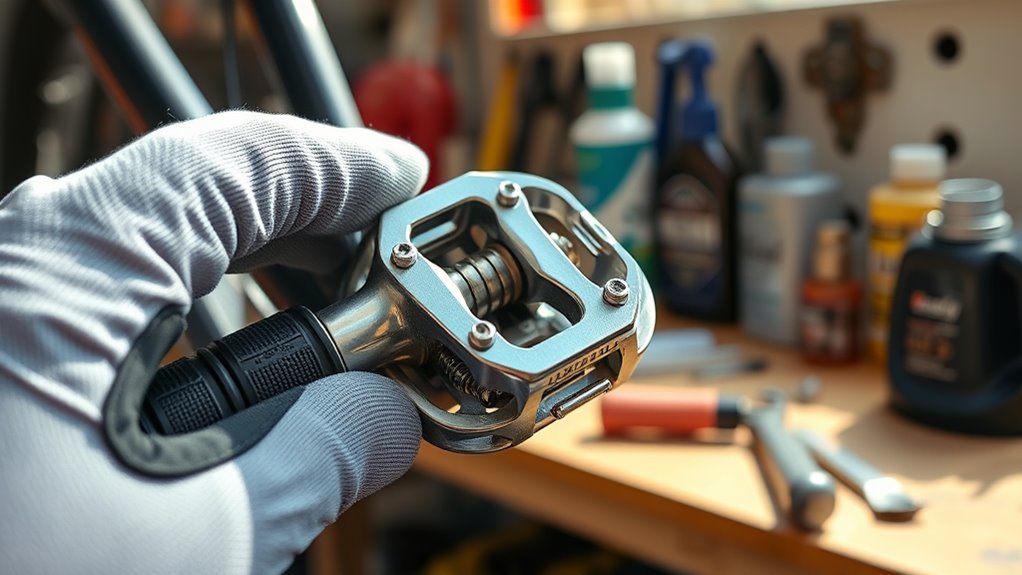
Regularly inspecting the engagement mechanism of your clipless pedals is essential to guarantee reliable clipping in and out. Over time, dirt, debris, or corrosion can cause the mechanism to stick or malfunction. Check the pedal materials—aluminum, composite, or steel—and verify the mechanism moves smoothly. Lightly lubricate the engagement area with a suitable bicycle lubricant to prevent rust and reduce friction. Be cautious not to over-lubricate, as excess oil can attract dirt. Keep in mind that pedal weight can influence how easily the mechanism engages; lightweight pedals might require more frequent maintenance. Properly maintaining your components ensures consistent performance, safer rides, and a longer lifespan for your pedals. By maintaining this part regularly, you ensure consistent performance, safer rides, and a longer lifespan for your pedals. Proper care minimizes the risk of sudden disengagement or difficulty clipping in.
Ensuring Proper Cleat and Pedal Compatibility
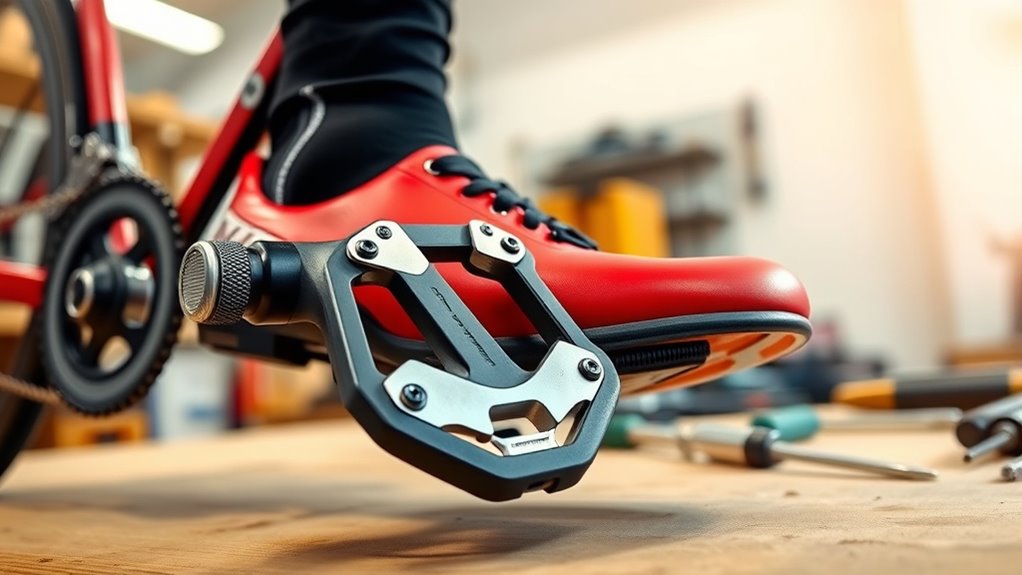
Ensuring your cleats and pedals are compatible is key to safe and efficient riding. Check the cleat materials, as they must match your pedal system—look for three-bolt or two-bolt designs depending on your pedals. The pedal weight also matters; lighter pedals can improve performance but may affect durability, so choose a weight that balances comfort and strength. Confirm that your cleats fit securely into the pedals without excessive movement or difficulty clipping in. Using incompatible cleats or pedals can cause slipping or difficulty engaging, risking your safety. Always verify the manufacturer’s specifications to guarantee proper compatibility. Proper matching of cleat materials and pedal weight helps optimize your riding experience, providing a secure connection and reducing potential issues during your ride. Additionally, understanding the Kia Tuning options available can improve your vehicle’s performance and handling, similar to how proper pedal and cleat compatibility enhances your ride.
Troubleshooting Common Clipping In and Out Issues

Are you having trouble clipping in or out smoothly? It’s common to face issues with pedal tension or cleat wear that hinder your clips. To troubleshoot:
Having trouble clipping in or out? Check tension and cleats for smooth, secure release.
- Adjust pedal tension – Increase tension for a firmer release or decrease for easier clipping.
- Check cleat wear – Worn cleats can cause slipping or difficulty clipping out; replace if needed.
- Ensure proper cleat positioning – Misaligned cleats can cause inconsistent clipping.
- Inspect pedal engagement – Make sure the cleat clicks securely into the pedal with a clear audible snap.
- Regularly monitor component condition, as wear and tension changes can impact performance over time.
Addressing pedal tension and replacing worn cleats usually resolves most clipping issues. Regularly check these components to keep clipping in and out smooth and safe.
Maintaining Your Pedals for Optimal Performance
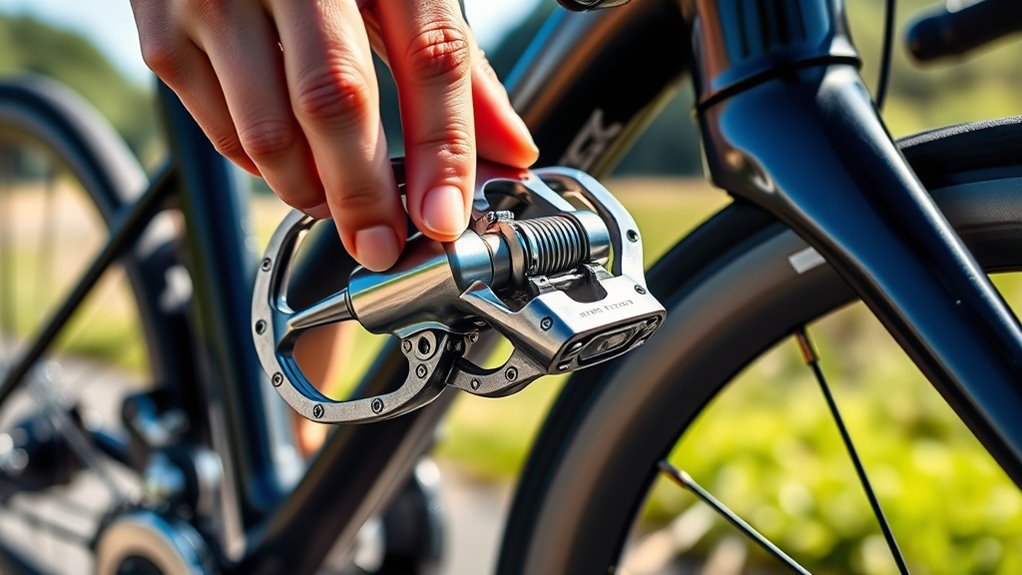
To keep your clipless pedals performing at their best, you need to perform routine maintenance that addresses dirt, corrosion, and general wear. Regularly check and adjust pedal tension to ensure your pedals release smoothly and securely. If tension is too tight or loose, it can cause clipping issues or accidental releases. Also, inspect your cleats for signs of wear, such as cracks or excessive wobbling, which can reduce clip-in reliability. Clean your pedals and cleats after rides to prevent dirt buildup that can compromise function. Lubricate moving parts as recommended by the manufacturer to prevent corrosion. Replacing worn cleats promptly maintains secure engagement and smooth clipping in and out. Proper maintenance ensures your pedals remain reliable, responsive, and safe during every ride. Additionally, using high-quality lubricants can help prolong the lifespan of your components and ensure smooth operation.
Frequently Asked Questions
How Often Should I Replace My Clipless Pedals?
You should replace your clipless pedals when they show significant wear or damage, typically every 2,000 to 3,000 miles, but it depends on your pedal lifespan and riding conditions. Regularly check for cracks, excessive play, or worn-out cleats. If you notice decreased performance or difficulty clipping in, it’s time for replacement. Staying attentive to these signs ensures safe riding and peak pedal function, extending the life of your pedals.
Can I Use Different Brands of Cleats Together?
Think of cleats like puzzle pieces; if they don’t fit perfectly, the connection isn’t secure. You can’t always mix brands because of compatibility issues—brand compatibility and cleat interchangeability vary widely. For example, some Shimano cleats won’t work smoothly with Look pedals. Always check manufacturer guidelines to confirm your cleats and pedals are compatible, or you risk poor engagement and safety concerns on your ride.
What Tools Do I Need for Pedal Maintenance?
To maintain your pedals, you’ll need a few essential tools. Grab a hex wrench or pedal wrench to loosen and tighten pedals, and a small brush or rag for cleaning. Use a bike-specific lubricant or grease for pedal lubrication to guarantee smooth operation. Check cleat alignment regularly and apply lubricant to the pedal threads to prevent rust. Proper maintenance keeps your pedals performing well and extends their lifespan.
How Do Temperature Changes Affect Pedal Performance?
You might notice your pedal performance changing with temperature swings, thanks to pedal material and temperature sensitivity. When it’s hot, certain materials like plastic can expand, making clipping in a bit tougher. Conversely, cold weather can cause metal parts to contract, potentially affecting smooth engagement. To keep your pedals functioning well, regularly check for looseness or stiffness, and consider using lubricants suited for different temperatures to maintain peak performance.
Are There Specific Safety Tips for Beginners?
As a beginner, you should always wear proper safety gear like a helmet, gloves, and reflective clothing to prevent accidents. Before riding, double-check your equipment and make sure your pedals are securely clipped in to avoid slips. Stay alert, follow traffic rules, and practice in safe, low-traffic areas. These safety tips help prevent accidents and build your confidence, making your cycling experience safer and more enjoyable.
Conclusion
With a few simple checks, you can turn your clipless pedals into a smooth, reliable part of your ride. Imagine gliding effortlessly, your feet snapping in and out with confidence as you navigate each pedal stroke. Regular maintenance and quick adjustments keep everything running seamlessly, so you can focus on the road ahead. Soon, clipping in will feel natural, and every ride will be a comfortable, secure experience—ready to conquer new miles with ease.
